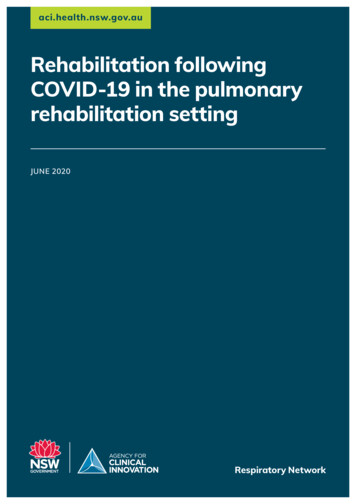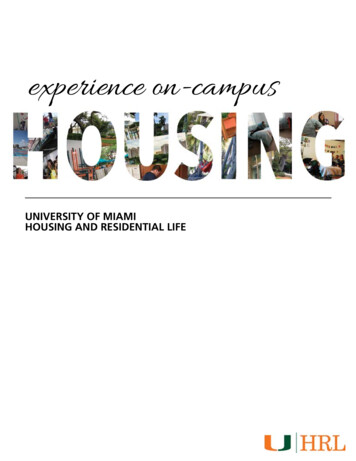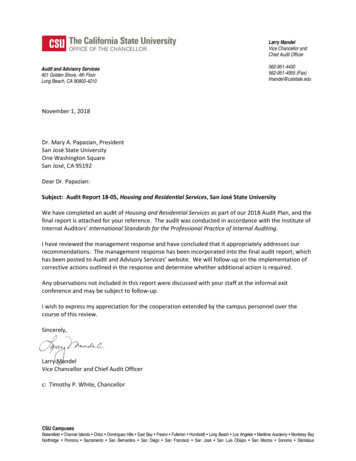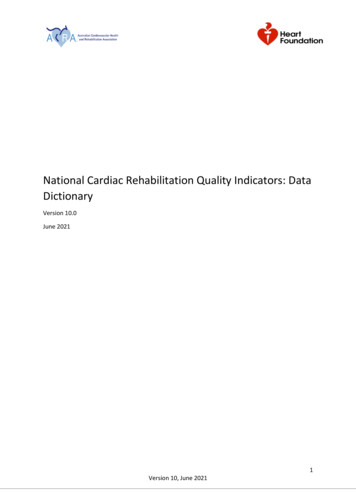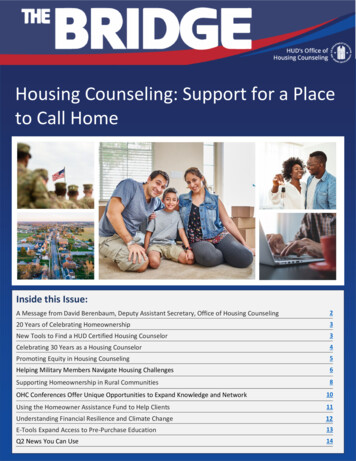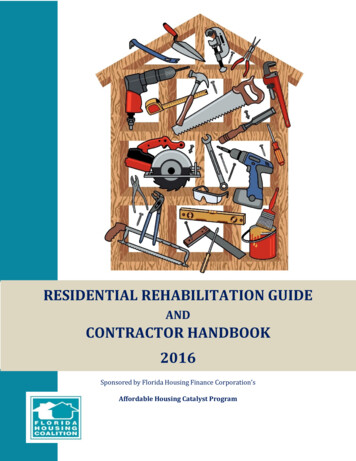
Transcription
RESIDENTIAL REHABILITATION GUIDEANDCONTRACTOR HANDBOOK2016Sponsored by Florida Housing Finance Corporation’sAffordable Housing Catalyst Program
ContentsABOUT THIS DOCUMENT . 6PART I.OVERVIEW OF SHIP REHABILITATION PROGRAMS. 8SHIP REHABILITATION PROGRAM DESIGN .8Housing Data .8Program Staff .9Funding Sources .12Construction Costs .13Preparing Local Housing Assistance Plan Rehabilitation Strategies .13SHIP REHABILITATION PROGRAM ADMINISTRATION AND ACTIVITY DELIVERY .15Working with Sub Recipients and Sponsors .15Putting the “Partnership” in SHIP .16Program Administration .17Recruiting, Selecting, and Working with Contractors .17Special Considerations for Mobile Homes .19Special Considerations for Special Needs Applicants .19Rehabilitation Standards and Specifications .20Conducting the Initial Inspection .21Prioritizing Repairs and Determining Project Feasibility under SHIP.23Work Write-Ups and Cost Estimates .24Green Building .25Universal Design and Visitability .25Mitigation Improvements .26OTHER CONSIDERATIONS .27Disputes .27Conflict of Interest .28Written Agreements .29Pitfalls to Avoid .29A NOTE ON ADAPTATION .30PART II. CONTRACTOR HANDBOOK TEMPLATE FOR LOCAL GOVERNMENT HOUSINGREHABILITATION PROGRAMS . 311.INTRODUCTION .312.APPLICATION .323.BID PROCESS.322
A.Invitation to Bid .32B.Mandatory Walk-Through .33C.Bid Proposal .34D.Bid Submittal .34E.Rehabilitation Contract Award .35F.Subcontractors.35G.Closing / Contract Signing .36H.Multi-Family Rental Rehabilitation .36I.Reconstruction Contract .37J.Emergency Contract .374.PAYMENT AND CONTRACT PERFORMANCE.37A.Draw Schedule .37B.Contractor Payments .38C.Payment Reduction .39D.Change Orders.40E.Suspensions and Disqualifications .40F.Lien Waivers .42G.Inspections .425.PROJECT RESPONSIBILITIES .42A.Government Responsibility.42B.Construction Agreement .42C.Contract Signee .42D.Access to Property.43E.Utilities .43F.Equipment Storage .43G.Personal Property .43H.Property Damage .43I.Permits and Impact Fees .44J.Warranties .44K.Disputes .44L.Room Completion .446.CONTRACTOR QUALITY AND STANDARDS .45A.Insurance .45B.Coordination of Work .45C.Codes .453
D.Licenses .45E.Material Quality .46F.Labor Quality.46G.Safety .46H.Clean-Up .46I.Completion Deadline .46J.Hold Harmless.47K.Regulations .47PART III.SAMPLE FORMS AND DOCUMENTS . 48CONTRACTOR CHECKLIST AND APPLICATION – SAMPLE .49AUTHORIZATION TO RELEASE CREDIT INFORMATION – SAMPLE.58COMPLIANCE CERTIFICATION FORM - SAMPLE .59PRE-BID ATTENDANCE FORM – SAMPLE.61INVITATION FOR BIDS – SAMPLE .62BID RESULTS – SAMPLE .63OWNER SELECTION OF CONTRACTOR FORM – SAMPLE .64CONTRACTOR/OWNER REHABILITATION AGREEMENT – SAMPLE.65OWNER AGREEMENT WITH CITY/COUNTY/AGENCY – SAMPLE .77CLOSING CONFERENCE REPORT – SAMPLE .81TRUTH-IN-LENDING STATEMENT – SAMPLE .82NOTICE TO PROCEED – SAMPLE.83SUBCONTRACTOR LIST FORM – SAMPLE .84CONTRACTOR PAYMENT REQUEST (DRAW) FORM – SAMPLE .85INSPECTION REPORT AND CHECKLIST – SAMPLE .86NOTICE OF COMMENCEMENT – SAMPLE .93CHANGE ORDER FORM – SAMPLE .96PUNCH LIST – SAMPLE .97RELEASE OF LIEN AND AFFIDAVIT OF CONTRACTOR – SAMPLE .98TERMINATION OF NOTICE OF COMMENCEMENT – SAMPLE .99PARTIAL WAIVER AND RELEASE OF LIEN – SAMPLE .100FINAL RELEASE OF LIEN – SAMPLE .102CONTRACTOR WARRANTY – SAMPLE.103CONTRACTOR EVALUATION FORM – SAMPLE .104MORTGAGE AND NOTE – SAMPLE .1054
MORTGAGE MODIFICATION FORM – SAMPLE .117APPENDIX A.SAMPLE SHIP OWNER-OCCUPIED REHABILITATION STRATEGY . 119APPENDIX B.GREEN BUILDING IMPROVEMENTS . 1215
ABOUT THIS DOCUMENTPurpose:The purpose of this Handbook is to assist local State Housing Initiatives Partnership Program(SHIP) Administrators working with Contractors to implement Rehabilitation Programsfunded by SHIP.Description:This Handbook is a tool to be used by SHIP Administrators, sponsors, and partners as a guidefor selecting and working with Contractors under the City/County/Agency’s SHIPRehabilitation Program and other housing programs. It provides customizable templatesthat may be used to create policies, procedures, forms, and guidelines under a RehabilitationProgram. Users of this Handbook may adapt it to be consistent with the locally adoptedand approved Local Housing Assistance Plan, program Policies and Procedures, and otherlocal laws and requirements.The Handbook consists of three parts: Part I provides an overview of SHIP rehabilitation program design, administration,and operation. Guidelines are provided for determining the nature and scope ofyour local rehabilitation programs; forming partnerships with Sub recipients,sponsors, and other local entities; recruiting, selecting, and working with contractors;conducting inspections; preparing work write-ups; creating rehabilitation standardsand specifications; incorporating elements of green building, universaldesign/visitability, and disaster mitigation in rehabilitation activities; avoidingdisputes, conflicts of interest, and other pitfalls; and preparing effective writtenagreements.Part II is a template for a Contractor Handbook that outlines policies and proceduresfor Contractor selection and participation in a local SHIP Rehabilitation Program.These policies and procedures represent best practices for collaboration betweenSHIP Administrators and Contractors for home rehabilitation, but may be changedand customized to reflect local needs, preferences, and ordinances. In customizingPart II, the SHIP Administrator should also fill in the blanks with project details andproject-specific requirements, and should replace certain bold, italicized, and/orunderlined text elements with the appropriate terms for the entity that administersthe local SHIP Rehabilitation Programs.6
Part III consists of templates for forms and documents that are commonly used inSHIP Rehabilitation Programs, including Contractor applications; pre-bidwalkthrough sheets; agreements among Contractors, property owners, and localgovernments; draw request forms; and mortgage documents for SHIP rehabilitationassistance. These forms should be adapted as necessary to reflect local governmentcircumstances. Any form or document that is referenced in the main body of a localgovernment’s Contractor Handbook, as adapted from Part I of this document, shouldbe included as an attachment, appendix, or exhibit in the Contractor Handbook.This Handbook focuses primarily on owner-occupied rehabilitation programs, but most ofits provisions are applicable to SHIP rental rehabilitation programs. When adapting thisHandbook and the sample forms in Part III for use in rental rehabilitation programs,provisions addressing homeowners should be adjusted to apply to rental property owners.Disclaimer:The Florida Housing Finance Corporation does not require you to produce a local Handbookor to use the information, templates, or forms in this Handbook. This Handbook is providedas an optional tool to help SHIP Administrators carry out their Rehabilitation Programs; it isfor information purposes only. This Handbook addresses many issues related to legalresponsibilities between parties; neither the Florida Housing Coalition nor the FloridaHousing Finance Corporation, is providing legal advice. Anyone using the information,templates, or forms in this Handbook should have these items reviewed/approved by theirlegal counsel, Board, City/County commission or governing body.The Florida Housing Coalition expresses its appreciation to the following individuals forproviding peer review based upon their professional experience. We are particularlygrateful to our member Bill Lazar of the St. Johns Housing Partnership for his assistance.Bill Lazar, St. Johns Housing PartnershipLeonard Grandio, City of HialeahMarie-Frantz Jean-Pharuns, City of North MiamiDorothy Sinan, City of Port St. LucieClay Milan, City of Hollywood7
PART I.OVERVIEW OF SHIP REHABILITATION PROGRAMSSHIP REHABILITATION PROGRAM DESIGNLocal governments have the ability to carry out one or several activities under ResidentialRehabilitation Programs included in the Local Housing Assistance Plan (LHAP), whichgoverns the local use of SHIP funds. Rehabilitation programs can include emergencyrepair programs, accessibility and disaster mitigation programs, energy-efficiencyimprovement programs, and general residential rehabilitation and reconstructionprograms.Local governments should consider several factors when deciding whichrehabilitation programs they will incorporate into their LHAP, including local needs, the staffcapacity of the local government housing program, the extent to which rehabilitation fundingsources other than SHIP are available, and local construction costs.Housing DataTo determine which rehabilitation activities should be eligible for SHIP assistance, a localgovernment should review available data on the community’s housing stock, housingconditions, and the needs of residents.Basic data on local housing stock and housing needs may be obtained from the followingsources: Shimberg Center for Housing Studies, University of Florida http://www.shimberg.ufl.edu/ earchresults.xhtml?refresh t . Census Bureau (American Community Survey and Decennial Census)U.S. Department of Housing and Urban Development (HUD) ComprehensiveHousing Affordability Strategy (CHAS)Consolidated Plans submitted to HUD by local government recipients of CommunityPlanning & Development (CPD) grants, including the Community DevelopmentBlock Grant (CDBG) and HOME Investment Partnerships Program (HOME) n/con-plans-aaps-capers/To obtain detailed local data on interior and exterior problems with the local housing stock,it may be necessary to conduct windshield surveys, review code enforcement data,8
administer surveys to very low-, low- and moderate-income homeowners, or work with aresearch institution to analyze American Housing Survey microdata for your area.Program StaffThe local government should also consider staffing. The number of employees available tocarry out your rehabilitation program and their housing experience are influential factors indeciding the type of assistance that will be provided in your community. If you have aprogram with one or two staff members, you may want to limit the activities authorized bythe LHAP.SHIP administrators should consider the use of qualified non-profit or for-profitorganizations as “Sub recipients” to assist in carrying out day-to-day operations or a specificaspect of program administration, such as inspections and work write-ups. The role of Subrecipients is discussed in further detail in the next section, SHIP Rehabilitation ProgramAdministration and Activity Delivery. When using Sub recipients to carry out all orportions of your program, follow your selection process as outlined in the LHAP and inaccordance with local procurement policies and procedures, execute written agreementswith these agencies, and monitor them on a regular basis to ensure compliance.Alternately, staff members from other City departments, such as the Building Department,may be able to assist with inspections and developing work write-ups. The duties of stafffrom other departments will be negotiated and should be clearly outlined in a Memorandumof Understanding or Agreement between the two departments.Many residents in your community may have Limited English Proficiency. LEP persons arethose whose proficiency in speaking, reading, writing, or understanding English, as a resultof national origin, is such that it would deny or limit their meaningful access to programs andservices provided by the local government if language assistance were not provided. HUDhas issued Executive Order 13166, signed on August 11, 2000, which directs all federalagencies, including the Department of Housing and Urban Development (HUD), to work toensure that programs receiving federal financial assistance provide meaningful access toLEP persons. If you have developed a plan to comply with this requirement under yourfederal programs, consider applying these same requirements under the SHIP program as abest practice. It is helpful to determine the largest language-minority population that yourorganization serves, and develop a plan to translate publications or hire a translator toensure that the applicants understand the specific requirements of the program. Languagebarriers can create confusion and misunderstandings which will often lead to disputes.9
The basic requirements of two key staff positions are described below. Additional detailsabout the duties of rehabilitation program staff should be detailed in a Policies andProcedures manual.Intake CounselorThe intake counselor responds to telephone inquiries from members of the publicwho are interested in rehabilitation assistance, reviews applications forrehabilitation assistance, and may also be responsible for maintaining the waiting list.Each rehabilitation strategy should have its own waiting list.The system forrecording calls and telephone applications should include mechanisms to avoidhuman error by the intake counselor.The best practice is to serve applicants on afirst-qualified, first served basis, rather than a first-come, first-served basis.The pre-screening process is important. The intake counselor should ask questionsabout the household’s program eligibility, unit eligibility and income eligibility. Forexample, the intake counselor should obtain information from each client on thelocation of the property to be rehabilitated, the type of property (single-family,duplex, etc.), the condition of the property, household size, household income, andother client needs (e.g. for wheelchair accessibility retrofits).An applicant who is determined to be eligible on a preliminary basis will then beplaced on the waiting list for the appropriate rehabilitation program. The intakecounselor must keep records of waiting lists even after all clients have been assistedto document that the waiting list existed and that the clients were served. Thewaiting list should also document when the client was assisted or disqualified andremoved from the list.The intake counselor will then contact the applicant and will set up an appointmentto meet with the applicant to review the application and all supportingdocumentation. The intake counselor should date-stamp all documents received,including the initial application.When reviewing a client’s application foreligibility, the intake counselor is responsible for asking clarifying questions aboutthe information provided, requesting any necessary documentation from the client,and obtaining third-party verifications, as detailed in the applicable Policies andProcedures manual.10
Housing InspectorA housing inspector is responsible for determining what repairs the home needs andif those repairs qualify under the program guidelines. A good housing inspector iscrucial to your rehabilitation program, and must be able to: Balance the relationship between the local government, the homeowner andthe contractorProvide clear work specifications to contractors as a means to reduce thelikelihood of change ordersEnsure that the work is of good quality and in accordance with thespecificationsEnsure that disputes about the quality of work or unforeseen obstacles toproject completion are resolved in a manner that is fair to all partiesEvaluate the need for change orders to the work scopeA SHIP administrator should review the experience and education of candidates forthe Housing Inspector position. Inspectors should be familiar with the FloridaBuilding Code as well as local codes that impact the repairs that will be performed inthe program. They should be familiar with inspection techniques and inspectionand cost estimating software programs; be able to read plans and drawings of thework to be performed; have knowledge of structural, mechanical, electrical andplumbing components; and have sufficient knowledge of labor and material costs inyour area to provide a good cost estimate for the work to be performed. Inspectorsshould also have good communication and listening skills, with the ability to be tactfulyet firm. Finally, inspectors should have good writing and computer skills, andshould be safe drivers.Once an inspector is hired, their duties and responsibilities should be clear. Theinspector should be able to provide clear and well-written rehabilitation standards,work write-ups, and other specifications, which help to reduce change orders andimprove the quality of work performed by Contractors that participate in yourprograms. Specific duties include: Conducting the initial property inspectionDeveloping the work write-up and specificationsConducting the pre-bid walkthrough11
Providing project oversightConducting required inspections for approval of draw requestsApproving paymentsMaintaining communication between all partiesPreparing and approving change ordersEnsuring that inspections have passedPreparing the punch listApproving final paymentFollowing up on warranty issuesInspectors should be provided with continuous training opportunities and the toolsneeded to perform their work, and should receive support from the housingprogram’s clerical staff. The SHIP administrator should solicit feedback on theinspector’s performance from homeowners and contractors who participate in therehabilitation programs, and the inspector should be rewarded for goodperformance.Rather than hiring an “in-house” inspector, your local government SHIPadministrator may prefer to contract with a third-party firm to
The Florida Housing Coalition expresses its appreciation to the following individuals for providing peer review based upon their professional experience. We are particularly grateful to our member Bill Lazar of the St. Johns Housing Partnership for his assistance. Bill Lazar, St. Johns Housing Partnership . Leonard Grandio, City of Hialeah

